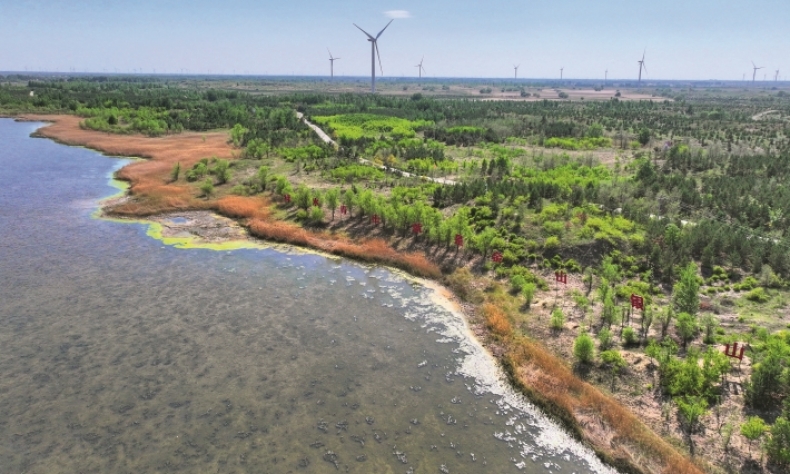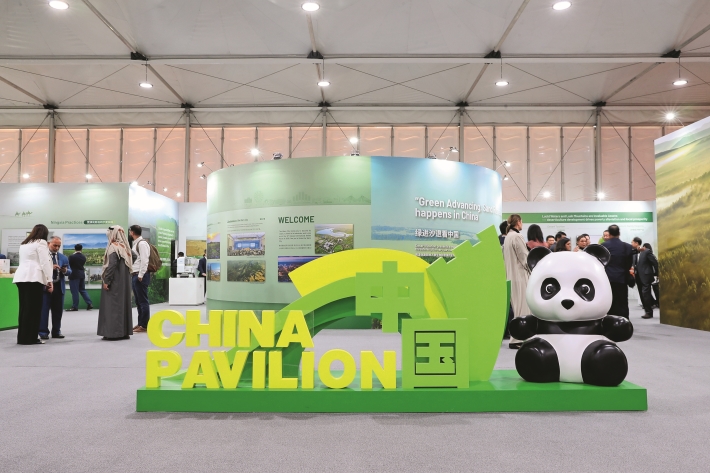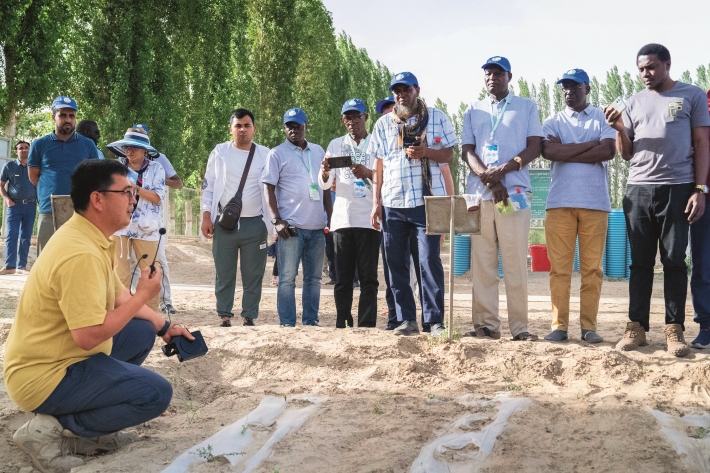Protecting Our Land

Over the 30 years since signing the UNCCD, China has been a steadfast supporter of global desertification control.
The 16th sessions of the Conference of the Parties (COP16) to the United Nations Convention to Combat Desertification (UNCCD) concluded in Riyadh, Saudi Arabia, on 14 December 2024. Centred around the theme Our Land Our Future, the conference adopted 39 resolutions addressing drought response, scientific innovation, dust storms, and future budgeting after 13 days of deliberations. These efforts have set a new blueprint for combating desertification and land degradation worldwide, opening a fresh chapter in global cooperation.
Notably, the conference commended China’s remarkable achievements in desertification control. A dedicated China Pavilion, spanning over 600 square metres, became a focal point, showcasing the country’s experiences and advancements in combating desertification and highlighting the Three-North Shelterbelt Programme (TSFP). This marked the first time China presented its desertification prevention and control initiatives on such a scale abroad.
China’s progress was also recognised four days earlier when Lu Qi, chief scientist of the Chinese Academy of Forestry and director of the Research Institute of Three-North Shelter Forest Programme, received the 2024 Champions of the Earth award from the United Nations Environment Programme (UNEP) in Nairobi, Kenya. This marked the first time a Chinese scientist was honoured with this accolade in the science and innovation category.
“The award not only acknowledges my personal accomplishments, but also reflects global recognition of China’s leadership in desertification prevention,” Lu told Xinhua News Agency.

Transforming deserts
Desertification represents one of humanity’s gravest ecological challenges. China, home to 2.57 million square km of desertified land – 26.81 percent of its total territory – and 1.68 million square km of sandified land, has emerged as a global leader in addressing this issue. Over the past four decades, through key ecological initiatives like the TSFP, China has achieved unparalleled success in desertification control.
By November 2024, the National Forestry and Grassland Administration reported significant progress: 53 percent of treatable sandified land had been effectively rehabilitated, resulting in a net reduction of approximately 4.33 million hectares of sandified areas. These efforts have enabled China to achieve zero growth in land degradation and a reduction in both desertified and sandified land areas, positioning it as the first country globally to meet such milestones.
A major progress was made in Xinjiang Uygur Autonomous Region, where lies the Taklamakan Desert, China’s largest desert and the world’s second-largest shifting desert. On 28 November 2024, the green belt of Three-North Shelter Forest encircling the 3,046-km periphery of the Taklamakan Desert was completed, marking the success of efforts spanning over four decades to prevent the desert’s expansion.
Inner Mongolia Autonomous Region, which serves as China’s northern ecological barrier and has long been another critical battleground in China’s desertification control campaign, has also made intensified effort in restoring the desert. By November 2024, desertification prevention and control tasks have been completed for 1.14 million hectares of land, surpassing the annual goal by 11.4 percent. Additionally, construction of 450 km of desert-crossing roads has been launched, enabling the restoration of 57,200 hectares of degraded land.
The region has also bolstered its efforts by establishing 40 nurseries covering 900 hectares, with 320 million saplings cultivated in 2024 alone. Grass seed production capacity now exceeds 8 million kg annually, ensuring a stable supply of seedlings for the TSFP. Furthermore, by addressing overgrazing through targeted pilot programmes, the region has significantly improved the grass-livestock balance in all 17 pilot counties. Cutting-edge drone surveillance and an integrated monitoring system have enhanced ecological protection.

Major achievements have also been made through key sand control initiatives including the TSFP, the Grain for Green Programme, and the Beijing-Tianjin Sandstorm Source Control Project. Huang Caiyi, head of the desertification control department of the National Forestry and Grassland Administration, said that over 35.87 million hectares of sandified land have been properly preserved, and 7.87 million hectares have been restored with these programmes. Forest coverage in the TSFP area has risen from 12.41 percent to 13.84 percent, with 61 percent of soil erosion under control.
China’s approach to desertification control goes beyond environmental restoration, integrating ecological conservation with economic development. Desert regions have embraced sustainable industries, including medicinal herb cultivation, high-quality forage, economic forests, and desert tourism, contributing to rural revitalisation.
Fulfilling global responsibility
Desertification is a global challenge. Combating desertification and halting and reversing land degradation is among the UN 2030 Agenda for Sustainable Development Goals.
Over the 30 years since signing the UNCCD, China has been a steadfast supporter of global desertification control. The country has met its 2030 land degradation neutrality target ahead of schedule and successfully hosted COP13 to the UNCCD, yielding significant outcomes. The TSFP has received the Global 500 Roll of Honour Award from the UNEP, and the UNCCD Secretariat has twice honoured China for its outstanding contribution to combating desertification.
China has also advanced desertification control through the Belt and Road Initiative. In 2016, it launched the Belt and Road Joint Action Initiative for Combating Desertification. This initiative facilitates cooperation among participating countries to combat land degradation and promote green development. China has founded desertification control centres in Mongolia and the Arab world and established demonstration bases in Central Asia and Africa. Over 100 Chinese desertification control technologies have been widely adopted across 40 countries.
China’s collaboration with Africa on the Great Green Wall project exemplifies its international contributions. Since 2006, China has introduced its desertification control expertise to the continent, making significant strides in recent years. Efforts include developing and demonstrating technologies, promoting Chinese approaches and materials, and building joint research laboratories. The China-Africa Green Technology Park in Mauritania incorporates modules for windbreaks, soil improvement, photovoltaic pumping systems, and water-saving irrigation, among others.
Looking ahead, Huang said, “China will continue to diligently fulfil the obligations under the UNCCD, contributing China’s strength to global desertification control.”
 Facebook
Facebook
 Twitter
Twitter
 Linkedin
Linkedin
 Google +
Google +










